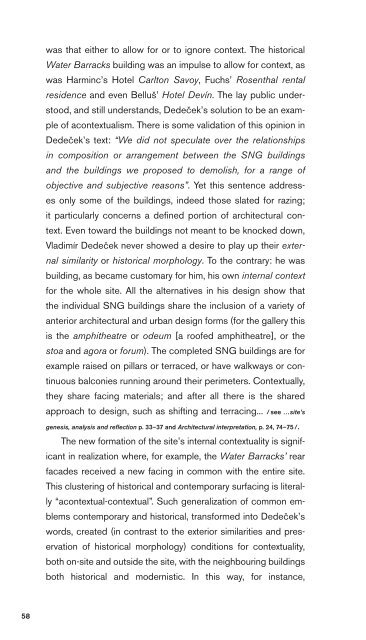sng_2016-05-12_high-single-crop_k3
You also want an ePaper? Increase the reach of your titles
YUMPU automatically turns print PDFs into web optimized ePapers that Google loves.
was that either to allow for or to ignore context. The historical<br />
Water Barracks building was an impulse to allow for context, as<br />
was Harminc’s Hotel Carlton Savoy, Fuchs’ Rosenthal rental<br />
residence and even Belluš’ Hotel Devín. The lay public understood,<br />
and still understands, Dedeček’s solution to be an example<br />
of acontextualism. There is some validation of this opinion in<br />
Dedeček’s text: “We did not speculate over the relationships<br />
in composition or arrangement between the SNG buildings<br />
and the buildings we proposed to demolish, for a range of<br />
objective and subjective reasons”. Yet this sentence addresses<br />
only some of the buildings, indeed those slated for razing;<br />
it particularly concerns a defined portion of architectural context.<br />
Even toward the buildings not meant to be knocked down,<br />
Vladimír Dedeček never showed a desire to play up their external<br />
similarity or historical morphology. To the contrary: he was<br />
building, as became customary for him, his own internal context<br />
for the whole site. All the alternatives in his design show that<br />
the individual SNG buildings share the inclusion of a variety of<br />
anterior architectural and urban design forms (for the gallery this<br />
is the amphitheatre or odeum [a roofed amphitheatre], or the<br />
stoa and agora or forum). The completed SNG buildings are for<br />
example raised on pillars or terraced, or have walkways or continuous<br />
balconies running around their perimeters. Contextually,<br />
they share facing materials; and after all there is the shared<br />
approach to design, such as shifting and terracing... / see …site’s<br />
genesis, analysis and reflection p. 33–37 and Architectural interpretation, p. 24, 74–75 /.<br />
The new formation of the site’s internal contextuality is significant<br />
in realization where, for example, the Water Barracks’ rear<br />
facades received a new facing in common with the entire site.<br />
This clustering of historical and contemporary surfacing is literally<br />
“acontextual-contextual”. Such generalization of common emblems<br />
contemporary and historical, transformed into Dedeček’s<br />
words, created (in contrast to the exterior similarities and preservation<br />
of historical morphology) conditions for contextuality,<br />
both on-site and outside the site, with the neighbouring buildings<br />
both historical and modernistic. In this way, for instance,<br />
58



